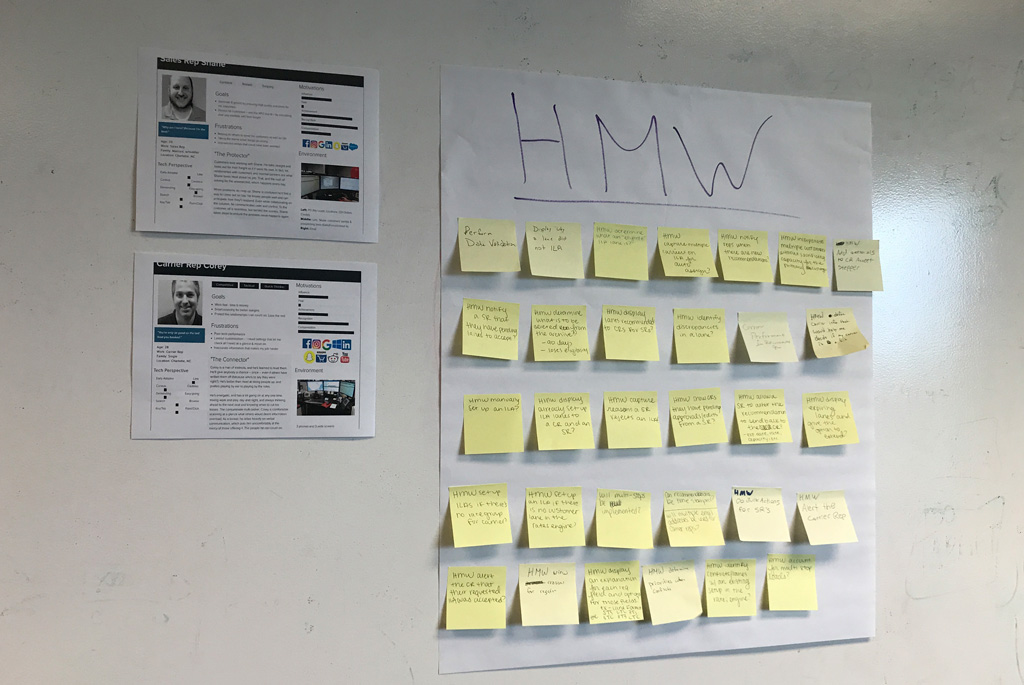Helping Carrier Reps get more contracted lanes
XPO Logistics is one of the world’s largest freight brokers, to be exact within the top 5 in 2019. They use a pairing of knowledgable Carrier Reps and technology to help pinpoint and pair the right customer’s needs with the right carriers to move commodities from point A to point B. There are times when the pairing is so mutually beneficial that a one-off haul can become a contracted lane.
My challenge was to redesign the current system of Intelligent Lane Assignment to decrease setup time, reduce data inaccuracies, and increase the number of contracted lanes for fulfillment prior to release to the spot market. The team’s hypothesis was by automating this process it would do just that.

Fall in love with the problem
As a Lead UX Designer on the project, I knew we first needed to start with defining the problem. So I went to the Product Owner and worked through the process of filling out an Experience Canvas in Confluence. In this, we developed out the problem statement, initial ideas, project value, stakeholders, personas, and more. We discovered that in the current state, Carrier Reps were relying on Systems Coaches and Pricing Team to provide Intelligent Lane Assignment (ILA) recommendations and ILA setup respectively. This leads to inaccuracies in data and delayed setup.
Our Initial Ideas
- Recommend eligible ILA Lanes to Carrier Reps
- Populate known data about the lane for Carrier Rep review and approval
- Streamline the sales rep ILA approval process
- Automate the process for the sales rep to approve ILA
- Prevent user error in the configuration of ILA contract
- Troubleshooting option to see similar lanes and why it might not work
Business Value
- Reduced time on task
- ILA setup
- Sourcing
- Troubleshooting
- We see an increase in the margin when we use a contracted carrier over a spot carrier
- Measuring margin on ILA vs non-ILA orders
- Reduction in manual resources to configure ILA.
- Workforce reduction or reallocation
User Roles & Personas
Carrier Reps – Primary
- Motivation is a guaranteed volume of business.
- Shift focus to procuring non-contracted freight
Sales Reps
- Motivation is a guaranteed capacity of freight at a decreased cost.
But still, how do we make the experience better for all the key users?
Enter the design thinking workshop. At this point, the ask was large enough and the data validated the need for a larger group to come together to solve this problem. We needed to design the solution together.
So together the product manager and I cobbled a team of 1 Product Manager, 1 Lead Designer/Facilitator (Me), 2 Offshore Designers, 1 Lead Developer, 1 Systems Coach/Pricing Analyst, and 2 Support Team members. Off I flew to North Carolina to collaborate on a solution.



The team spent about 4 days together defining, discussing, sketching, mapping out on a whiteboard flows, interviewing users, and putting together low-fi paper prototypes. We came out with an experience for the Reps to create and except recommendations. Also, an experience for system coaches and support team members to build rules to automate the recommendations.
Going from low-fi to high fives
Everyone separated and the design team went to work in Sketch and InVision. The next steps were to put together a first iteration design prototype that we could test with the Sales Reps and Carrier reps. Phew, here we go off to the UX Researcher and results.


After the concept testing the UX Team came back together with the Product Owner, made some decisions on how to iterate, and finalize a design to be ready for development grooming.
The end is never the end in good product design
As I reflect I think to myself, there is always something I would change, and I have. But I am happy with the outcome? Why, because all the right players were involved. “Design” was considered first in the process vs waiting to the tail end of the product design process after the debt was gained.
The great news when launched in 2020 this tool can meet the businesses’ goal of assigning 250,000 loads using ILA which will provide a $7.5M in SG&A Cost Savings and saving approx. $30 a load.
Key Aspects:
• User-centric design
• User validation
• Design thinking workshop
Technologies Used:
Confluence, Sketch, Miro Board, InVision
To comply with my non-disclosure agreement, I have omitted and made unclear confidential information in this case study. All information is my own and does not necessarily reflect the views of XPO Logistics.